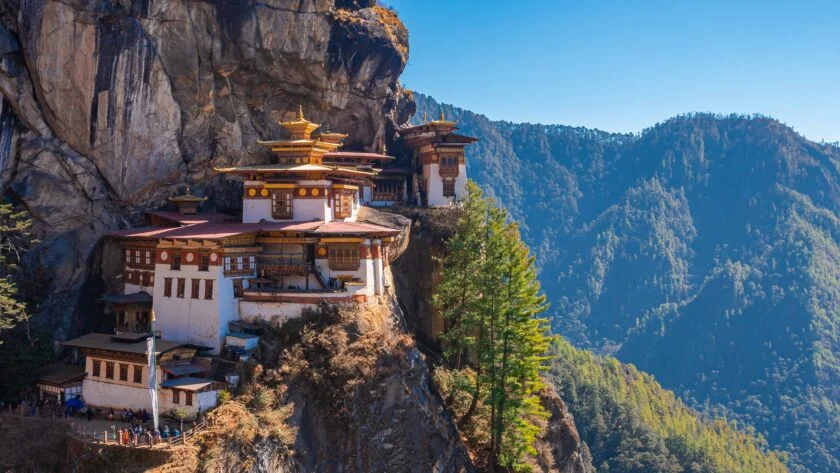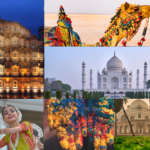Bhutan is a poster child for happiness and green living. With 70 per cent forest cover and power generation virtually entirely from mountain streams, Bhutan stands as an example of today’s environmental problems.
It is the only nation on the planet to change is the first to achieve carbon neutrality. Considering Bhutan’s political agenda anchors on the GNH index, environmental protection has swiftly become a primary issue.
Bhutan and Environment
With a population of little over 760,000 people, Bhutan exists between the political boundaries of the economic and Asian powerhouses, China and India.
The Kingdom of Bhutan is known around the world for its unusual percentage of overall development: Gross National Happiness (GNH).

Picture Credits@ Kinshuk Bose
Furthermore, the constitution of Bhutan mandates that Bhutan keeps (at all times) 60 per cent of its land under forest cover. And to be honest, Bhutan has been successful and prosperous in this endeavour.
Moreover, 51% of the country’s continuous forests, the highest amount of any Asian country are all kept safe with the majority of it is made up of intact forests that intertwine with free-flowing rivers.
No doubt, evidence of this conservationist zeal are present in all of Bhutan. The country’s 5-million-acre network of protected areas is home to endangered royal Bengal tigers, elusive snow leopards, exquisite black cranes, and elephants.
Bhutan and its Gross National Happiness (GNH)
The term well-being here refers to meeting requirements of a “good life” which defines the idea of Gross National Happiness.
The four pillars of GNH have frequently been used to introduce the idea:
- excellent governance,
- sustainable socio-economic development,
- cultural preservation, and
- environmental conservation.
Furthermore, recently the four pillars have been subdivided into nine dimensions to promote a broader knowledge of GNH and convey the full range of GNH ideals.
Thus, the nine dimensions are psychological well-being, health, education, time use, cultural variety and resilience, good governance, community vitality, ecological diversity and strength, and living standards. The dimensions represent every aspect of Bhutanese people’s well-being.
In addition, the citizens of this Buddhist country retain a fundamental birthright: to live in a healthy environment. Likewise, one of the country’s most important industries, ecotourism, is flourishing and expanding due to Bhutan’s environmental consciousness.
What is Carbon negative?
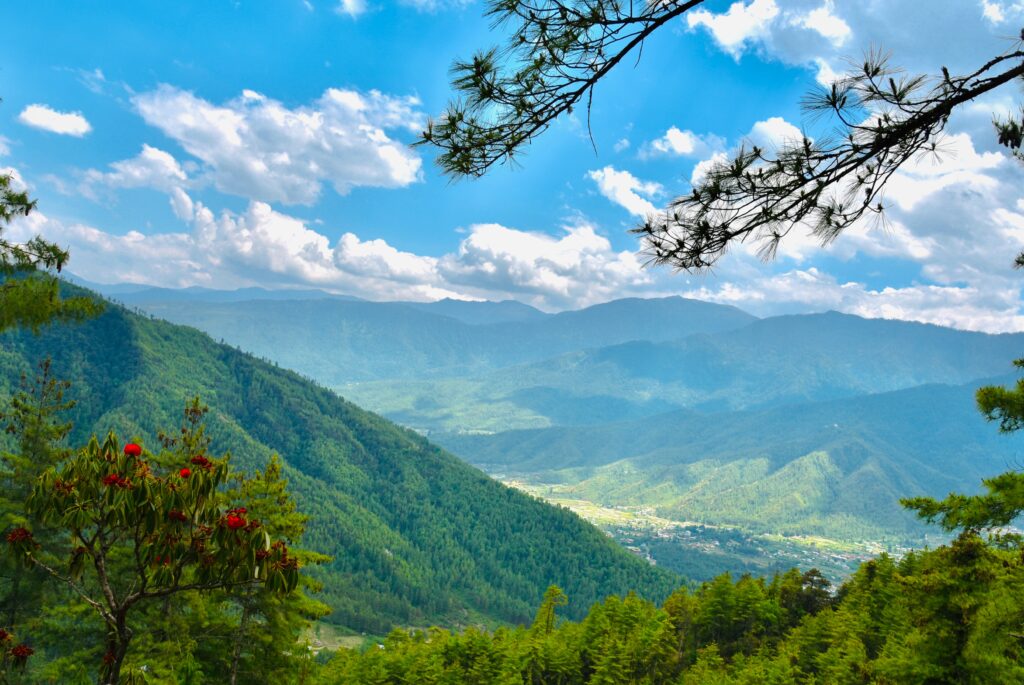
Picture Credits@ Darshan Chudasa
As we know, several economies emit significantly more carbon dioxide than the planet’s oceans and plant life can assimilate. Therefore, as a result, these countries are considerably contributing to the climate crisis.
However, the Kingdom of Bhutan, on the other hand, makes an impression. More than 70% of the nation is covered with forest. Thus, Bhutan has become a carbon sink, absorbing more carbon dioxide than it emits.
Moreover, Bhutan also exports the majority of the renewable hydroelectric electricity generated by its rivers. This dramatically offsets the country’s annual contribution to carbon emissions.

Picture Credits@ Ej Wolfson
A land untouched by Globalization
Bhutan’s sovereignty and identity are defined through culture. Culture and development are not only fundamental but also vital for long-term growth.
In addition, Individual and community cultural values and moral implications are the cornerstones of any nation’s socio-economic development. Bhutan, a tiny Himalayan kingdom surrounded by the Himalayas, is practically unspoiled by Globalization.
Furthermore, Bhutan’s culture and traditional values are heavily entrenched in Buddhism. Religion, cultural values, and beliefs directly influence people’s behaviour, perception, and everyday routines.
Thus, one of the four pillars in implementing the country’s development philosophy of Gross National Happiness is preserving and promoting culture (GNH). Some of the significant highlights of Bhutanese culture are-
Losey
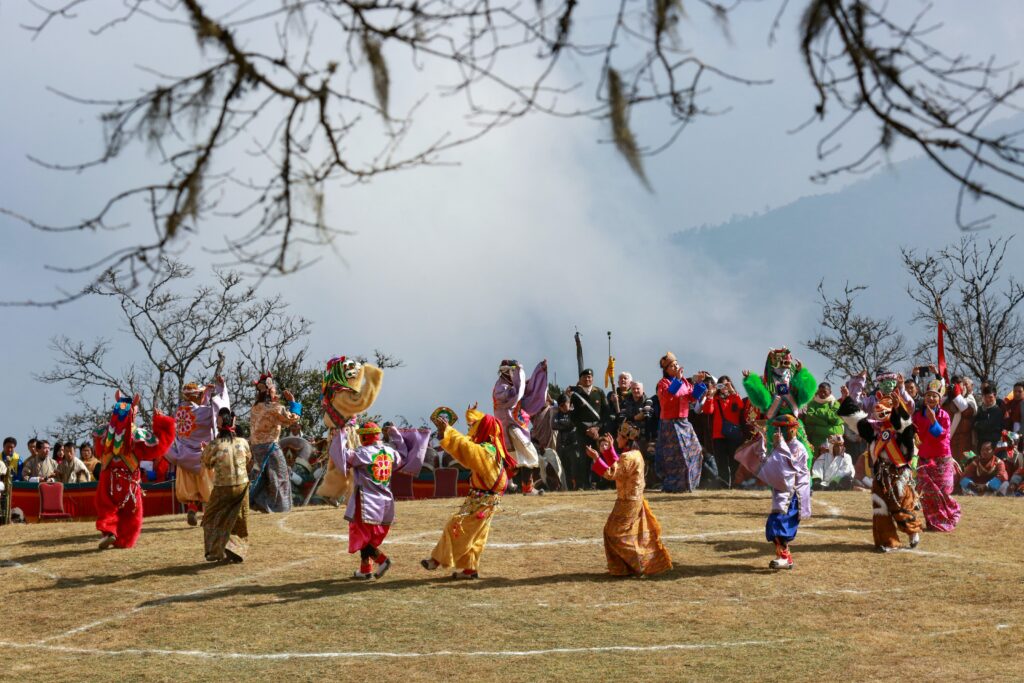
Picture Credits@ Pema Gyamtsho
Firstly, Bhutan has a great heritage of oral storytelling, lozey, ole (traditional and lengthy song), and tsangmo (lyrics). Lozey means ‘clear or clever intellect,’ although it could also indicate ‘ornament of speech.’
Secondly, this aspect has more to do with the natural talent and culture of the Bhutansese people. According to Karma Ura’s (1998) The Ballad of Pemi Tshewang Tashi: A Wind-Borne Feather, “during gatherings, men, women, and children, who may not be able to read or write, contest with individuals or in groups in lozey banter.”
Losey is a popular culture in western Bhutan’s Dzongkha-speaking communities such as Sha, Wang, and Paro. It is also a sort of natural recreation that reduces stress and mental burdens. According to legend, lozay is an indigenous oral poetic creation.
Intangible values of Bhutan

Picture Credits@ Suhash Villuri
Bhutan’s culture and traditional values are heavily entrenched in Buddhism. One of the fundamental intangible principles inherent in Bhutan’s traditions and culture is Lay Jumdray Thadamtsig (understanding the cause and effect of good and evil conduct, intentions, and holy devotion to others in society).
To understand in detail, Jumdray Thadamtsig’s notion asserts that “good breeds good and vice versa.” According to a case study report published by RAPA in 2009, Thadamtsig can be categorized into three categories:
- love and respect for one’s parents because they have given one’s valuable life;
- commitment between spouses to be faithful throughout life;
- relation between seniors and the younger generation.
Masked Dance of Bhutan

Picture Credits@ Pema Gyamtsho
Masked dances are done at religious festivals throughout Bhutan to celebrate different occasions at various periods of the year. Some sacred dances are strictly done by monks, while others are performed by laypeople.
Each dance has its own set of dancing clothes, rhythm, and movement, as well as its own importance. Masked dances are thought to be spiritually blessed.
It is believed that seeing the dances will free you from the circle of misery, also known as Samsara.
Traditional Dress of Bhutan

Picture Credits@ Atharva Whaval
Bhutanese culture requires traditional attire to be worn on significant occasions and at government offices. Bhutanese males dress in ‘Gho,’ while women dress in ‘Kira.’
Gho is a heavy knee-length robe linked with a belt. Kira is an ankle-length dress that can be paired with a short jacket. These outfits have changed over time.
For example, the small pockets on the front of the clothing were once meant to store food bowls and tiny daggers, but now they hold mobile phones and other items.
These gowns are constructed of cotton or wool, while silk dresses are reserved for special occasions. In addition, it is customary to wear a scarf when visiting a dzong or administrative centre.
Cuisine and culinary

Picture Credits@ Rohit Arora
The simplicity of Bhutanese culture is one of its most defining characteristics. As a result, it is not surprising that its food reflects this.
Food prepared on earthenware is traditionally eaten with hands while sitting cross-legged on the floor. However, cutlery and a dining table are now used in cities, and food is prepared using contemporary appliances.
Typically, the family woman serves the food to the other members, with the eldest member being served first.
Bhutan’s national dish is Ema Datshi. It is consumed throughout the country and in nearly every meal. It is often made up of fiery chiles and cheese. Momos, another Bhutanese speciality, are packed with pig, beef, or cabbage.
Literature
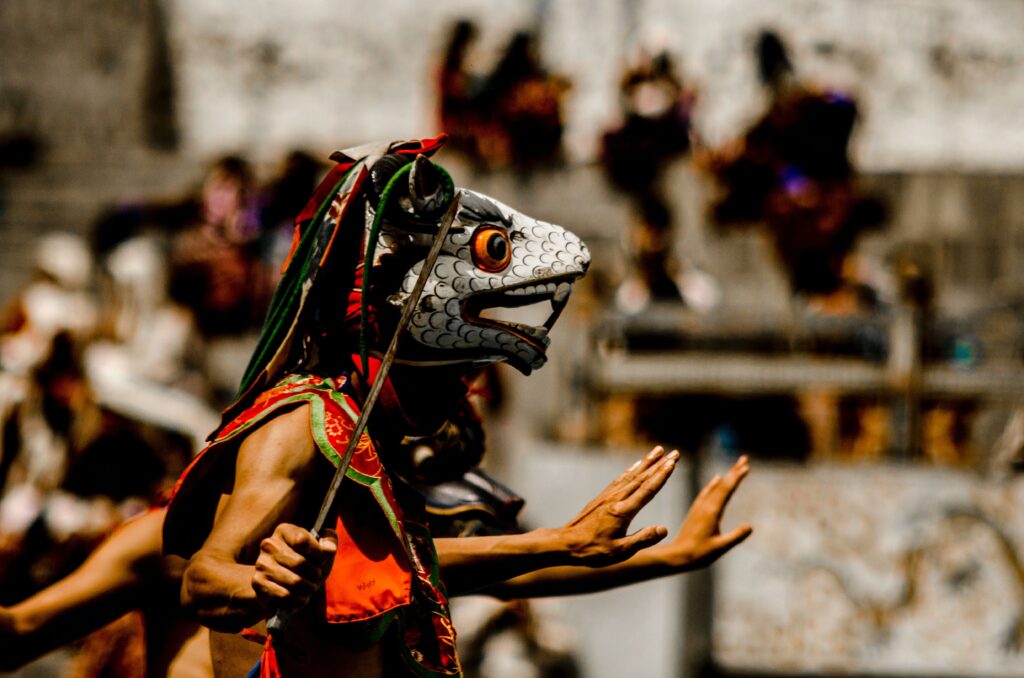
Picture Credits@ Ujwal Hollica
In Bhutan, oral literature has received more attention than written literature. This is because Bhutanese orally pass on their learning of religion, academics, and culture to the next generation.
Nevertheless, a large portion of the written literature has been reported in Nepalese. The rationale for this is that Nepalese was widely used in the country before the 1960s.
Architecture & Housing

A decorated pillar. 
Wodden engravings
Another aspect that distinguishes Bhutanese culture is its architecture. Traditional architecture, which includes slanted roofs, mud walls, and elaborate timber work, continues to thrive under the country’s terrain and climate.
The phalluses on the wall are revered. There is no usage of iron nails in the building.
Bhutanese culture is one of the few in the world celebrated and a source of pride for all citizens. Every day, its people respect and embrace the distinctive culture in its proper form while also working hard to conserve and promote the ideals established.
Closing Remarks

Picture Credits@ Bradford Zak.
A tranquil setting with holy monasteries, beautiful valleys, steep mountains, and pure rivers holds much more than meets the eye. Bhutanese culture intrigues everyone who encounters it.
The people’s and government’s commitment to maintain and develop their cultural values is even better. This is why its essence may still be found in every crevice of the land.
Festivals, architecture, food, and traditional dress are all essential aspects of Bhutanese culture.
Still curious about exploring more of Bhutan. To understand more, click the link here.
By Jaya Singh.

The term Jaya and coffee have become synonymous nowadays. Besides being a self-proclaimed connoisseur of coffee, Jaya is a voracious reader and law student who engages in firey discussions.
She is the junior editor at The International Prism and believes in the idea of not fitting into something; instead believes in breaking norms and making a mark for herself.
The author can be reached at jayasingh@theinternationalprism.com

